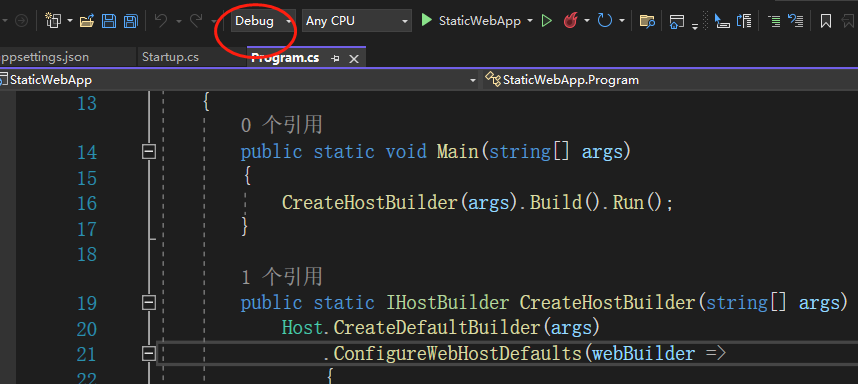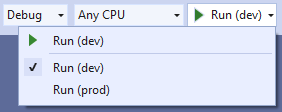- A+
开发人员在开发代码的时候,经常会使用到Debug、Release、Development、Production等几个概念,虽然有些地方在功能上最终殊途同归,但是还是有非常大的区别。
首先需要搞清楚,Debug、Release都属于编译配置,而Development、Production则属于环境配置。
作为开发者,开发时如果需要切换开发与发布环境的配置文件,两种方案都可以实现。
编译配置
思路很简单,在Debug模式下,就使用开发版本的配置项,在Release模式下,就使用正式版的配置项。开发的时候,只要通过鼠标点点切换就好了,非常方便。

Debug与Release控制编译器的行为,两者的区别挺多的,其中编译器优化这个可以查看我的一篇上古的文章。Debug配置定义了编译符号:DEBUG,Release定义了编译符号:RELEASE。
在代码中可以通过两种方式感知这个编译符号:
使用编译器预处理指令#if
public static async Task Main(string[] args) { IHost host = Host.CreateDefaultBuilder(args) .ConfigureServices(services => { var provider = services.BuildServiceProvider(); #if DEBUG services.AddDbContext<ManagementDataContext>(options => options.UseNpgsql(provider.GetRequiredService<IConfiguration>().GetConnectionString("DebugConnection"))); #else services.AddDbContext<ManagementDataContext>(options => options.UseNpgsql(provider.GetRequiredService<IConfiguration>().GetConnectionString("ReleaseConnection"))); #endif }) .Build(); await host.RunAsync(); } 编译器预处理语句,优点是简单,缺点是需要选择的分支特别多时,显得非常乱。
预处理语句将在编译中直接生成对应的代码,编译完成的程序中,看不到任何有关选择的过程。
使用ConditionalAttribute
ConditionalAttribute是一种特性标识,可以读取调用方(如果没有就是自己)的编译符号自动选择代码。
[Conditional("DEBUG")] private static void ConfigNpgsqlDebug(IServiceCollection services) { var provider = services.BuildServiceProvider(); services.AddDbContext<ManagementDataContext>(options => options.UseNpgsql(provider.GetRequiredService<IConfiguration>().GetConnectionString("DebugConnection"))); } [Conditional("RELEASE")] private static void ConfigNpgsqlRelease(IServiceCollection services) { var provider = services.BuildServiceProvider(); services.AddDbContext<ManagementDataContext>(options => options.UseNpgsql(provider.GetRequiredService<IConfiguration>().GetConnectionString("ReleaseConnection"))); } public static async Task Main(string[] args) { IHost host = Host.CreateDefaultBuilder(args) .ConfigureServices(services => { ConfigNpgsqlDebug(services); ConfigNpgsqlRelease(services); }) .Build(); await host.RunAsync(); } 注意,编译器会根据实际情况将对应代码编译进程序中,Debug模式下,Release段的代码和对应的引用都不会执行。这种方式比较优雅简洁,不过只能标识方法或者属性,有一定局限性。
ConditionalAttribute会保留到最终的程序集中,因此在编译后的程序中能看到这个Attribute。
环境配置
思路是程序在运行的过程中,读取环境变量,通过不同的环境变量切换不同的配置文件。
关于环境配置官方有一篇非常详细的文档。我们就使用默认的Development和Production两种环境变量配置。环境变量并不能在代码中固化,在开发时,需要使用设置对应的IDE环境。将配置分别写在appsettings.Development.json和appsettings.Production.json两个文件中,配置项目都为MonitorConnection,只是值不同。
官方文档对配置文件会加载
appsettings.{Environment}.json,默认情况下,如果不指定环境变量,那么会认为是Production。
调用代码非常简单,不需要对环境进行的特别识别:
public static async Task Main(string[] args) { IHost host = Host.CreateDefaultBuilder(args) .ConfigureServices(services => { services.AddDbContext<ManagementDataContext>(options => options.UseNpgsql(Configuration.GetConnectionString("MonitorConnection"))); }) .Build(); await host.RunAsync(); } 然后我们设置IDE,以VS为例,找到项目对应的launchSettings.json,修改成类似如下的代码。
"profiles": { "WebApi(Dev)": { "commandName": "Project", "launchBrowser": true, "launchUrl": "swagger", "environmentVariables": { "ASPNETCORE_ENVIRONMENT": "Development" } }, "WebApi(Prod)": { "commandName": "Project", "launchBrowser": true, "launchUrl": "swagger", "environmentVariables": { "ASPNETCORE_ENVIRONMENT": "Production" } } } 保存文件,在IDE上面就能出现这样的界面。

这样就能通过选择不同的运行环境来自动切换不同的配置文件了。
总结
两种方法虽然最终的结果类似,但是区别还是挺大的:
- 使用编译配置,运行时将保持固定,不能再切换;而环境配置可以通过变更环境变量的形式动态调整(对docker友好)。
- 使用编译配置,往往同时绑定编译时候的其他flag(优化、pdb生成之类),不是非常灵活。
- 代码上,使用编译配置往往需要使用更多的代码实现,而环境变量往往不需要额外的代码。
综上,个人认为使用环境变量进行切换会更加方便与灵活。




